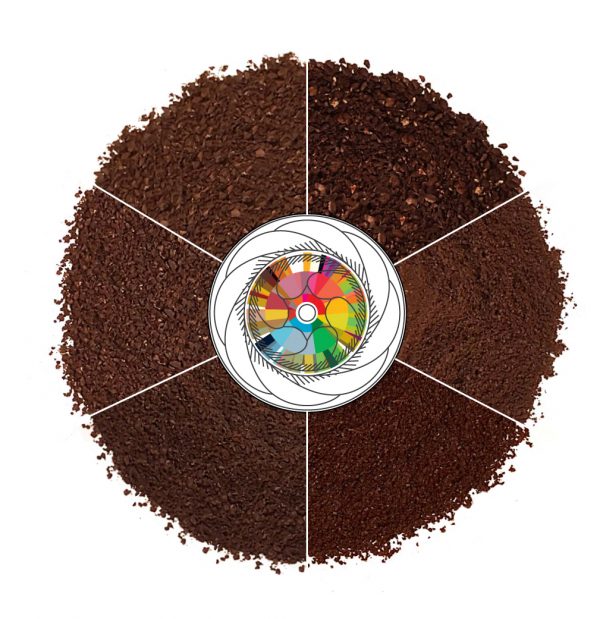Grinding degree is the first factor to adjust the flavor of coffee! What is the most appropriate grinding scale?
Professional coffee knowledge exchange More coffee bean information Please pay attention to coffee workshop (Weixin Official Accounts cafe_style)
Coffee drinkers are constantly pursuing a goal: how to make good coffee? Although taste perception depends on personal preference, there is a set of standards among aficionados to judge whether coffee tastes right. Instead of talking about coffee sources and treatments today, let's talk about another factor that coffee brewers can control: coffee grind size.

Xiaobian often comes into contact with some coffee novices, who already have high requirements for taste, but have no concept of how to make that taste. Ask them,"What's your abrasive setting?" The answer is usually,"Same as last time." The "last time" could have been a year ago. Xiaobian often contacts espresso, so the next explanation will enter from the perspective of espresso. The concept of abrasiveness is nothing new to veterans, but there are still many people who don't understand it.
Grind is the first factor in adjusting coffee flavor, more important than machine performance.

Allow me to repeat:
Grindness is the first factor in modifying coffee flavor.
For espresso, for example, we typically calibrate in the following order:
Bean grinder (grinding degree) grind size
powder dosage
extraction time

Grinding degree> Powder amount> Extraction time
The first question to ask yourself when coffee flavor is out of whack is,"Is this under-extraction or over-extraction?" After realizing the lack of flavor, the next question is:
Is the grinding right? Should it be thinner or thicker?
If the taste is sour, the tail is insufficient, and the taste is thin, it is a typical insufficient extraction. At this time, the coffee should be ground to a finer degree, and the coffee surface area should be increased to improve the extraction rate.
If the taste is bitter, the tail is too long, and the taste is heavy, it is typical of over-extraction. At this time, the coffee should be ground coarsely to reduce the surface area of the coffee to avoid extracting bitter substances.

When adjusting the grinding degree, keep other parameters fixed, especially the powder amount. Some people think coffee is not strong enough, so increase the powder. This idea is not completely wrong, but as long as the grinding degree can be adjusted to solve the problem does not need to waste more coffee powder, and powder bowls also have powder limit: a single powder bowl can hold about 8-10 grams; double powder bowl is 18-20 grams.

So how fine/coarse is the most appropriate grinding degree? Visually, when coffee is ground properly, the coffee will flow out about 4-5 seconds after extraction begins. The texture is sticky like honey, but it does not drip slowly (over extraction) or pour out (under extraction), and extracts 30ml of coffee solution in 20-30 seconds.
To learn to brew delicious coffee, grinding is the first basic skill that must be practiced. And it's not just espresso. The same principle applies to hand-brewed coffee, or even tea.
END
Important Notice :
前街咖啡 FrontStreet Coffee has moved to new addredd:
FrontStreet Coffee Address: 315,Donghua East Road,GuangZhou
Tel:020 38364473
- Prev

What's the difference between a smart cup and a V60 filter cup? The difference between the taste of smart cup and hand-brewed coffee
Professional coffee knowledge exchange more coffee bean information please follow the coffee workshop (Wechat official account cafe_style) smart cup extraction mode to soak in fact, water accounts for more than 98% of the content per drop of coffee. The index used by the American Fine Coffee Association to quantify the concentration is the total solubility measured by an optical refractometer.
- Next

Kenya Coffee Bean Flavor description the difference between Kenyan Coffee AA and AB Grade Coffee beans
Kenyan Coffee-http://blog.sina.com.cn/s/blog_472bb98a0102x37x.html Flavor quality Kenyan coffee is aromatic, full-bodied, fruity and has a rich and perfect taste. It tastes like BlackBerry and grapefruit and is a favorite of many coffee gluttons. This coffee has an excellent medium purity, crisp and refreshing taste. Symmetrical particles
Related
- What is the Philharmonic pressure? How to use Philharmonic pressure to make delicious coffee
- Why does a hand grinder have more fine powder than an electric grinder?
- In addition to the hot mom, what is the difference between the versions of EK43 | ditting and Mahdi ek43?
- What kind of equipment do you need to make coffee by hand? Introduction to novice starter cooking equipment tools
- Espresso needs to be ground how thick and thin scale entry Italian Coffee Machine Bean Grinder investigation and Grinding course
- How much does it cost to open a small private cafe? How much does it cost to learn coffee? How to operate it?
- The difference between the flavor characteristics of hand-brewed coffee and coffee maker is hand-brewed coffee really better than coffee maker? Can I use a coffee machine to make coffee beans by hand?
- The difference between 01 and 02 of hario v60 filter cup what is the difference between 01 and 02 filter cup opening and cooking flavor
- What's the difference between the smart cup and the French kettle? Which is better, the French kettle or the Smart Cup?
- What's the difference between a smart cup and a V60 filter cup? The difference between the taste of smart cup and hand-brewed coffee

